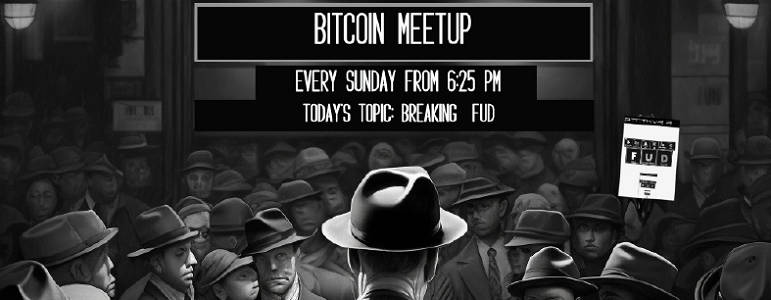Breaking ChatGPT’s Bitcoin FUD#6: Limited Use Cases – part 4…

We continue Vlad Costea’s “Breaking FUD” series. Vlad finishes up with the 6th “top threat” to Bitcoin according to ChatGPT. Let’s learn more about what the Lightning Network can do for you.
On to the segment from the e-magazine “BTCTKVR 3: Breaking FUD”, released May 2023. I’ll keep posting the rest of this e-magazine over the coming days.
“Breaking ChatGPT’s Bitcoin FUD#6: Limited Use Cases – part 4SCALABILITY, TRANSACTIONS, LAYERS, SHITCOINS, PROTOCOLS
The value proposition for Lightning network is that, for the price of two on-chain transactions, users can transact hundreds (if not thousands of times) at the speed of their internet connections and at a significantly lower cost. However, the main issue is routing – in order for a payment to get from wallet A to wallet B, the two of them need to either open a channel between each other or have a third party which connects them. As the liquidity increases, big hubs emerge – users naturally gravitate towards the nodes with the most economic activity (shops, dedicated companies which provide infrastructure). And if this influx of liquidity is accompanied by obvious choices for common hubs, then the lonely islands will become fewer and the odds to connect nodes become greater.
What’s great about Lightning is that it can act as the foundation for other layers that can leverage its speed and flexibility in order to do other stuff. For example, RGB aims to make the Ethereum design obsolete with client-side validation, while Taro seeks to bring a USD stablecoin to enable more trading options. There’s also Portal and Fabric, which contribute with atomic swaps, computation and data storage. And if your Lightning transactions aren’t private enough, then Chaumian mints such as Cashu and Fedi will come to the rescue. But before we get to these, let’s talk about John Carvalho’s Synonym.
Synonym describes a whole suite of applications and integrations: from Bitkit (Bitcoin toolkit) to Blocktank (a Lightning service provider), there’s a lot to discover. But the truly unique product is Slashtags – a tool that makes identity across web a lot easier. With only a Bitcoin and Lightning wallet (currently provided by Bitkit), anyone can set up a profile, build their reputation, and make their contributions easily discoverable under a simple mobile-friendly interface.
In a nutshell, Synonym’s Slashtags attempts to fix the censorship problem across the internet in a way which incentivizes good faith. Your profile is platform-independent to the point that any website with a Slashtags integration will enable you to comment and participate in debates, and there’s also a Lightning payments dimension on top of it. Facebook and Google attempted something similar in the mid 2000s, except that they always had control over the profiles to the point that they could shut down, restrict, and censor accounts.
Currently, Metamask attempts to do something similar for assets across the Ethereum ecosystem: a browser integration which makes it easy to log into other applications and protocols. However, the scope of Metamask is limited to financial applications. Slashtags cover a wider spectrum of use cases which include commenting across websites and building a reputation. So once again, the Bitcoin version does more and does it better.
Another interesting project is Portal, a DeFi platform which makes use of atomic swaps on the Lightning network. It’s being built by some of the veterans who created the first Bitcoin meet-up in Silicon Valley (most notably, George Burke), it’s backed by capital from a bunch of big, centralized exchanges (most notably, Coinbase and OKEX), and it aims to become a scalable replacement for custodial exchanges. So far, Portal has successfully managed to perform a successful cross-chain L2 swap between Bitcoin and Ethereum – without the need for “bridges” or wrapped coins. In time, the project’s scope is expected to grow.
Fabric is a protocol which takes the ambitions of the Lightning network to the next level, as it aims to build a computation layer for data storage and trustless application deployment.
The official description is that of an “operating system for the world’s most powerful super computer”, but the data storage plans extend the scope beyond the app store ambitions. Fabric was first announced in February 2016 and chief architect Eric Martindale has reported some breakthroughs with early prototypes. However, the project is yet to get deployed at its full scale.
RGB, Taro, Fedi and Cashu are also third layers built on top of the Lightning network. Though there are some technical similarities between them, their purposes are very different. RGB is a smart-contract system based on Bitcoin and Lightning Network, which benefits from client-side validation and enables instant transfers of asset ownership. So if Bitcoin Heads digital collectible cards get moved to RGB, then collectors can exchange them within seconds and at significantly lower costs than making on-chain transactions.
Conceptually speaking, Taro by Lightning Labs is very similar to RGB – to the point where RGB creator and lead developer Maxim Orlovsky slammed their tactic to copy parts of the code without giving credit and then raise millions of dollars for the final product. However, Taro is more explicitly being built to put “the world’s currencies” (aka stablecoins) on the Lightning network. RGB is universal in design and aims to empower users to build a worldwide economy where they can fundraise via secure tokenized company shares, trade digital collectibles, and more. Basically a more scalable, elegant, and private version of the stuff happening on Ethereum today.
Taro has a narrower and more specialized role, as it’s using the Lightning network as the settlement layer for other types of currencies. It appears to be focused on bringing the dollar to Lightning, but other types of fiat money will definitely follow. If properly funded, RGB can technically replace the need for Taro – but this type of competition, where one side has more ideas while the other has more capital, might turn out to be healthy for innovation.
Fedi and Cashu are the latest additions to Bitcoin’s layer 3 stack. They are very similar in design, as they both create Chaumian mints for anonymity. But it’s the tiny differences that make them unique in their own way. Firstly, Eric Sirion’s Fedi serves the purpose of creating community banks which make onboarding easy and accessible for people who are generally afraid of self-custody. People in small towns, villages, or members of various clubs and religious groups can pool their bitcoins together and trust a handful of figures who set up a multisignature wallet to give birth to the mint. The advantage is that everybody’s transactions are private and nobody can see how much money everyone else has. The only information that everyone can observe is the total amount of BTC in the mint.
However, Fedi’s disadvantages are social and political. Community banks are easier to censor and shut down than a decentralized global network of computers. Furthermore, the creators of the mint can coordinate to steal the funds – of course, this comes with a reputation cost among the community… but it’s still possible.
On the other hand, Cashu is designed in order to improve on Lightning’s privacy limitations. Creator Calle has looked into Chaumian e-cash to get some inspiration for a system where people pool in their money in order to maximize their transaction privacy. On the Lightning network, only the sender benefits from good privacy… while the receiver remains exposed. The major difference between Fedi and Cashu is that the former relies on a federation, while the latter optimizes individual self-custody. Cashu is also excellent to use with custodial Lightning wallets, to prevent the node operator from knowing who you are, how much funds you own, and with whom you’re transacting. This also removes the custodian’s power to censor users.
Initially, this article was meant to be a simple enumeration of the layers and protocols that make Bitcoin much more complex and capable than the mainstream media and the makers of ChatGPT portray it as. But the “pet rock with limited use cases” FUD is recurrent and takes many shapes and forms – ranging from “Bitcoin is not Turing complete” to “Bitcoin offers no yield”. So it was important to highlight the efforts of Bitcoin maximalists who constantly improve and expand the network towards new frontiers.
ChatGPT takes the most painful loss with this one, as it was completely unable to provide nuance and made a fool of itself and its WorldCoin shilling creators.
SCOREVlad 6
ChatGPT 0″
Vlad demonstrates how Bitcoin has unlimited potential and the future looks bright for building all types of cool features on top of Bitcoin.
I’m Charles Polanski and I seek to turn the Bitcoin-curious into Bitcoin investors and enthusiasts.
Thanks to Vlad for making this excerpt available to freely spread.Find him on Twitter: @TheVladCostea
“Your Bitcoin influencer’s influencer.”
Host of the Bitcoin Takeover Podcast
Writer of the open source @btctkvr mag.
Check out his work: http://linktr.ee/btctkvr
